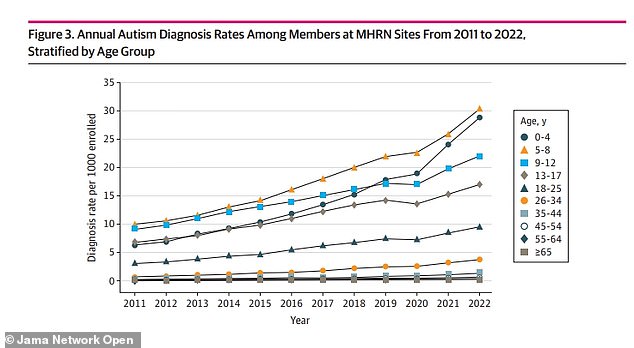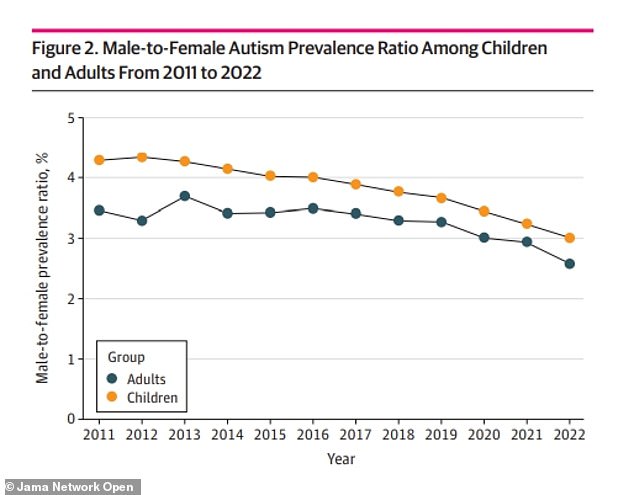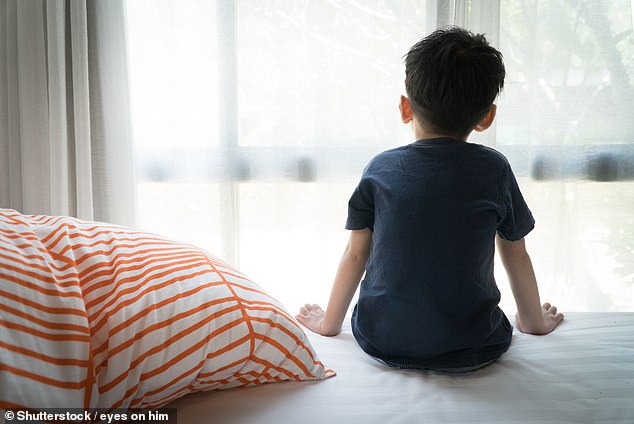Data show that autism in children and young adults in the United States has increased over the past decade.
An analysis of millions of medical records found that among all age groups, diagnoses increased 175 percent between 2011 and 2022, from a rate of 2.3 to 6.3 per 1,000 people.
The largest increase was among young adults ages 26 to 34, with a 450 percent increase.
But children aged five to eight remain the group most likely to be diagnosed, with a rate of 30 per 1,000.
Researchers say better screening, greater awareness and broader diagnostic criteria are driving the increase.
But recent studies have also pointed out that environmental factors such as pollution and aging mothers also play a role.
Researchers also noted that the autism “gender gap” is closing as more girls and women are diagnosed with the condition, which primarily affects school-aged children.
A study published this week found that autism diagnoses increased 175 percent between 2011 and 2022, which is likely due to increased screening, especially in adults, girls and women.

The graph above shows increases in autism diagnoses from 2011 to 2022 by age group.
But they warned that the actual rates are likely even higher than anticipated, since not all autistic children have access to screening and therapy.
They wrote: ‘The rates reported here may underestimate the true prevalence of ASD in adults, especially in older adult women, as many would not have been screened in childhood and would remain undiagnosed.
“However, our findings indicate that the population of autistic adults in the US will continue to grow, underscoring the need to expand health care services.”
However, other nations such as the United Kingdom face an even greater increase. A recent NHS report, for example, found that 200,000 Britons are waiting for an autism assessment, 30,000 more than last year.
According to the CDC, about one in 36 American children and one in 50 adults have autism.
Generally, most sufferers of this disorder are diagnosed at age five, although some can be tested as young as two years old.
While experts still don’t know what causes the condition, recent research suggests that environmental factors such as pollution, illness during pregnancy, and older parental age could be to blame.
The most recent study, published Wednesday in Open JAMA Networkanalyzed 12.2 million Americans enrolled at 12 sites in the Mental Health Research Network, a group of U.S. mental health centers.
Of them, 77,683 were diagnosed with autism.
Most of the autistic participants were between zero and four years old, closely followed by those between five and eight years old.
Participants were then divided into age groups ranging from infancy to 65 years and older.
Diagnoses decreased with age, and the smallest percentage (1 in 200) of the group was over 65 years of age.
Boys and men outnumbered girls and women three to one, what experts have suggested could be due to genetic and hormonal mutations more common in children.

The graph above shows the gap in autism diagnoses between men and women, suggesting that diagnoses in women are catching up with those in men.
Researchers believe the increases in diagnoses are due to “changes in developmental screening practices” of children and changes in “diagnostic definitions, policies, and environmental factors.”
Dr. Luke Grosvenor, lead author of the study and a postdoctoral researcher at Kaiser Permanente’s Northern California Research Division, said USA today that rising rates of autism in adults show that “we need to improve transition services for autistic people and their families.”
He noted that while autistic children often gain access to services such as speech therapy at school, they may lose access as adults. He said it is “critically important” that adults have access to these resources.
Other studies have suggested that environmental factors could be behind the increase.
An Australian study published earlier this year, for example, found that children exposed to the endocrine-disrupting chemical bisphenol A (BPA) in utero were six times more likely to be diagnosed with autism before age 11 than those without exposure.
That team suggested that BPA was associated with neurological and behavioral changes associated with autism.
Furthermore, a review 2021 found that “the odds of an autism diagnosis were 3.3 times higher in individuals born prematurely than in the general population,” as premature babies are vulnerable to birth complications and inflammation associated with autism.
This means the rise in autism could be due to more premature babies surviving birth, as the survival rate increased from 76 percent in 2008 to 2012 to 78.3 percent in 2013 to 2018, according to National Institutes of Health research (NIH).
The new study had several limitations, including that diagnoses were likely underestimated since the team relied only on those documented in medical records. The study also excludes patients without access to testing and doctors, such as those without insurance.
The team wrote, “Future work should characterize prevalence trends based on these and other factors to represent individuals with different levels of ASD service needs and presentations.”

